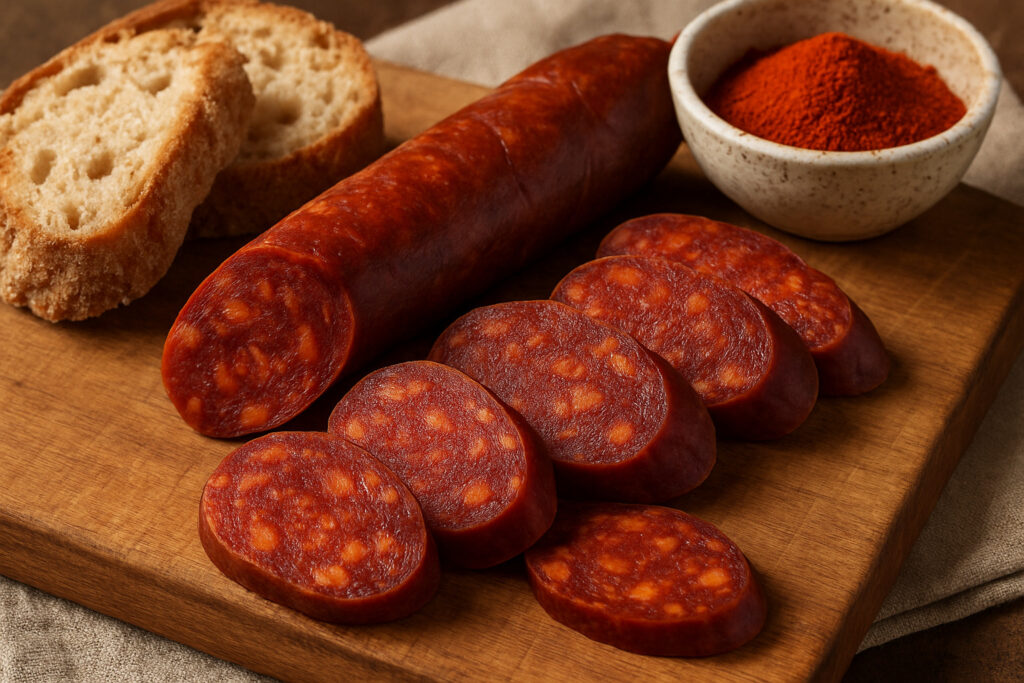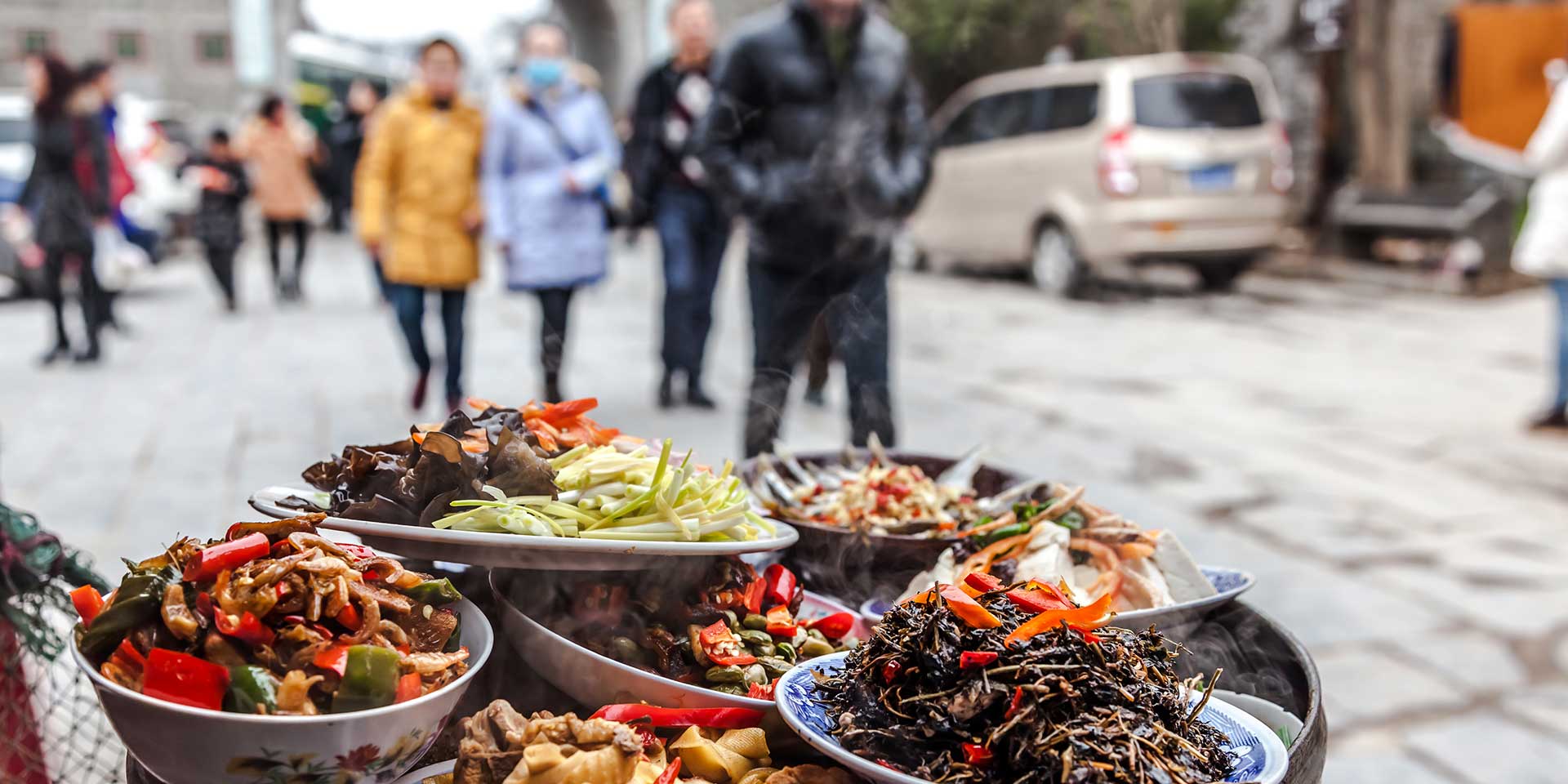Why Chorizo Captivates Food Lovers Worldwide
Chorizo is a spiced pork sausage that originated on the Iberian Peninsula and has spread across the globe, adapting to local tastes and traditions in dozens of unique regional varieties.
Quick Chorizo Facts:
- Origin: Spain and Portugal (16th century)
- Main Types: Spanish (cured/smoked) vs Mexican (fresh/raw)
- Key Ingredient: Paprika (Spanish) or chile peppers (Mexican)
- Colors: Deep red from pimentón or annatto
- Uses: Tapas, tacos, paella, breakfast dishes
- Varieties: 8+ Portuguese and 2+ Spanish EU-protected types
Whether you’re biting into a crispy chorizo taco on a Mexico City street corner or savoring thin slices of Spanish chorizo seco with Manchego cheese, you’re experiencing centuries of culinary evolution. This humble sausage has traveled from medieval Iberian villages to modern kitchens worldwide, picking up new spices, techniques, and flavors along the way.
The magic of chorizo lies in its incredible diversity. Spanish chorizo gets its smoky depth from pimentón (smoked paprika), while Mexican chorizo bursts with heat from ground chiles and vinegar. Portuguese chouriço adds cinnamon and wine, and Filipino longganisa brings sweetness to the mix.
For food travelers seeking authentic flavors, chorizo offers a delicious window into local culture – from traditional Spanish festivals where families still make chorizo during La Matanza pig-slaughter celebrations to busy Mexican markets where vendors grill fresh chorizo for breakfast tortas.
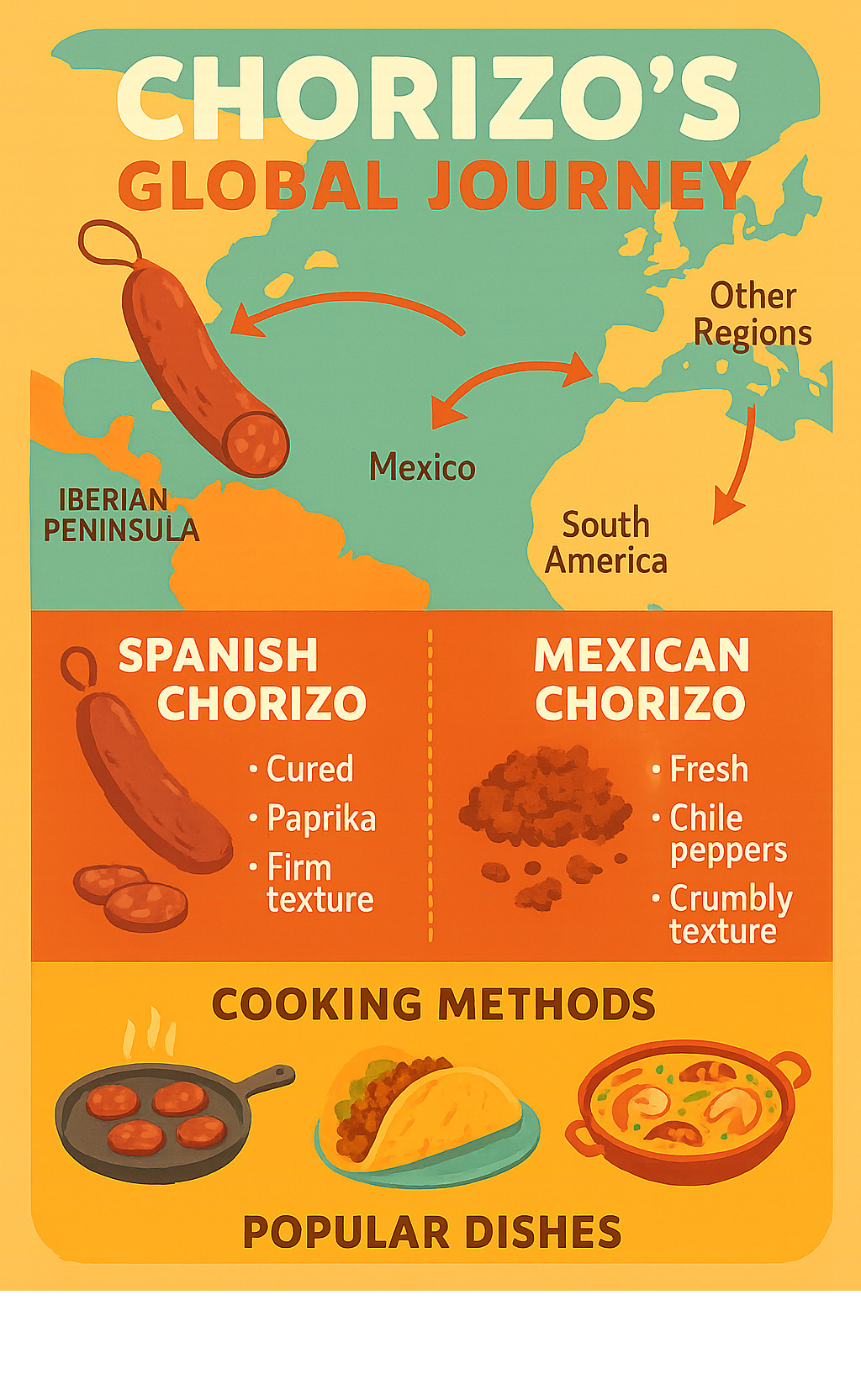
Essential chorizo terms:
What Is Chorizo?
Picture biting into a slice of deep red sausage that immediately fills your mouth with smoky, paprika-rich flavor. That’s chorizo – a spiced pork sausage that began its journey on the Iberian Peninsula and has since conquered kitchens worldwide.
Chorizo starts with chopped pork meat and fat, but what makes it special is the seasoning. The signature ingredient is paprika – called pimentón in Spain or colorau in Portugal. This isn’t just any paprika, but often smoked dried red peppers that give chorizo both its vibrant red color and complex, smoky taste.
The word “chorizo” traces back through Portuguese souriço to Late Latin salsīcia, sharing linguistic roots with Spanish salchicha (sausage). But don’t let that fool you into thinking chorizo is just another sausage – it’s in a league of its own.
The biggest divide is between cured and fresh varieties. Spanish chorizo is typically fermented, cured, and often smoked, which means you can slice it up and eat it straight from the package. Mexican chorizo takes a different path – it’s fresh and raw, requiring cooking before you can enjoy it.
This fundamental difference changes everything about how you store, handle, and cook with chorizo. It’s like comparing aged cheese to fresh mozzarella – both are delicious, but they serve completely different purposes in the kitchen.
Chorizo vs. Other Sausages
Walk through any deli section and you’ll see plenty of red sausages that might look like chorizo at first glance. But once you know what to look for, the differences become clear.
Pepperoni might share that appealing red color, but it’s actually an American creation with Italian influences. Made with beef and pork, it gets its heat from paprika and chili peppers. While always cured like Spanish chorizo, pepperoni has a firmer bite and lacks chorizo’s distinctive smoky depth.
Salchichón is chorizo’s mild-mannered Spanish cousin. Instead of paprika’s bold red punch, it relies on black pepper for seasoning, giving it a pale, almost white appearance.
Bratwurst from Germany takes yet another approach. Made with pork and veal, it’s seasoned with herbs like marjoram and caraway. Always sold fresh, bratwurst has none of chorizo’s paprika fire or signature red color.
The beauty of chorizo lies in how it stands apart from these other sausages. That smoky paprika flavor and deep red color aren’t just for show – they’re the result of centuries of perfecting a recipe that turns simple pork into something extraordinary.
Global Types of Chorizo
What makes chorizo truly fascinating is how it transformed as it traveled the world. When Spanish and Portuguese explorers set sail centuries ago, they carried their sausage-making traditions with them. But instead of staying exactly the same, chorizo adapted to local tastes, ingredients, and cooking styles wherever it landed.
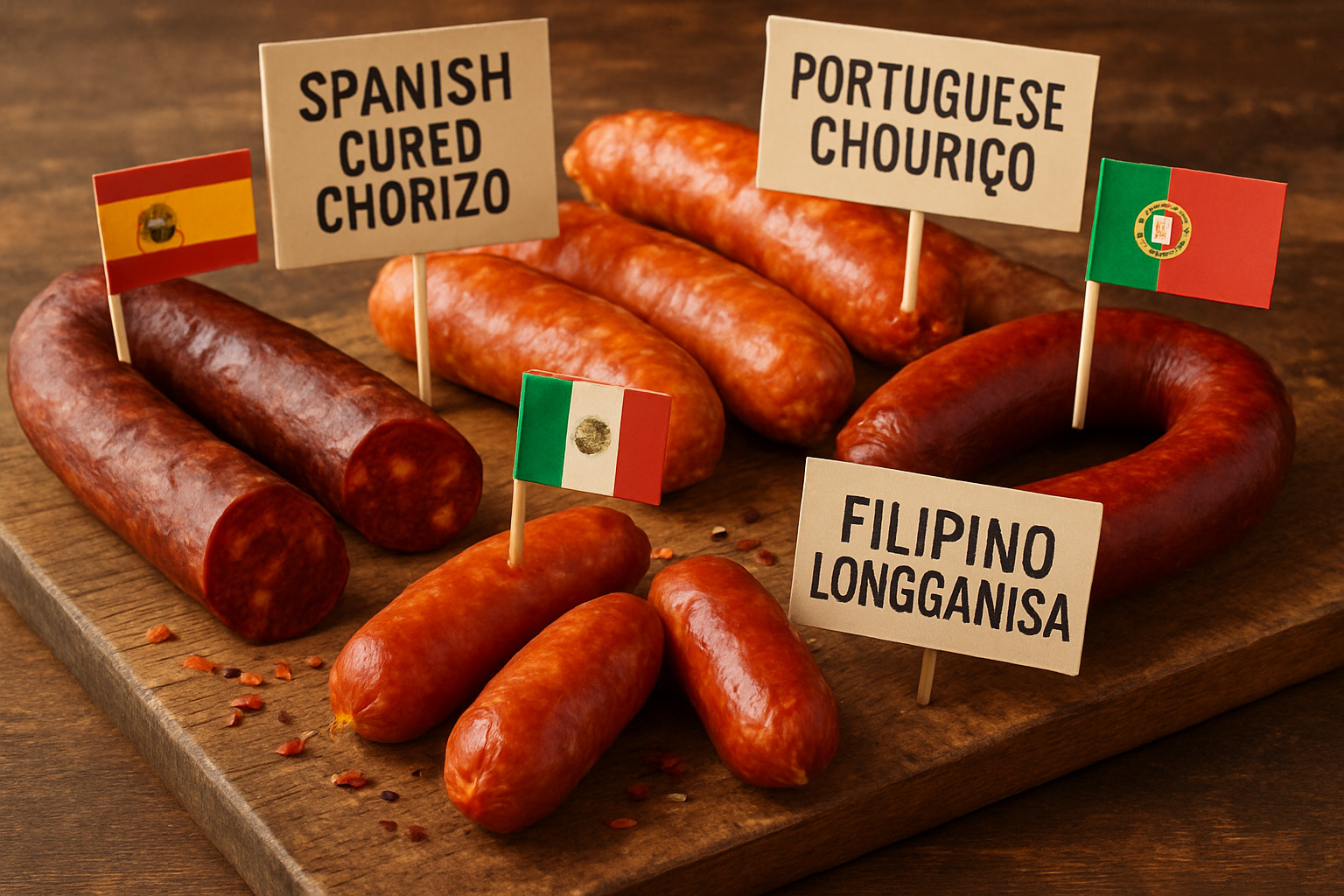
The result? A global family of sausages that share the same DNA but taste completely different. The European Union alone recognizes 8 varieties of Portuguese chouriço and 2 Spanish varieties as protected regional specialties. That’s just the tip of the iceberg when you consider how chorizo has evolved from Mexico to the Philippines.
Spanish Chorizo Styles
Spanish chorizo is where it all began, and the variety is mind-blowing. Every region has its own recipe, but they all fall into two main camps: picante (spicy) or dulce (sweet). Here’s a helpful trick locals use – long, thin chorizos are usually sweet, while the short, stubby ones pack more heat.
Chorizo Ibérico sits at the top of the Spanish chorizo pyramid. Made from acorn-fed Iberian pigs, this premium sausage has a nutty, complex flavor that comes from pigs roaming oak forests and munching on acorns. The bellota grade represents the finest quality, where the pigs’ diet creates beautifully marbled meat.
Cantimpalos Chorizo from Segovia earned its Protected Geographical Indication status the hard way – through centuries of perfecting the craft. These thick sausages must cure for at least 21 days and showcase traditional Spanish techniques at their finest.
La Rioja Chorizo also enjoys protected status and perfectly balances paprika with garlic. The region’s oak-smoking tradition adds layers of flavor that pair beautifully with local wines. The smoking process uses oak wood specifically because it complements rather than overpowers the meat’s natural taste.
Traditional Spanish curing takes about 50 days in carefully controlled conditions. The result is a firm, sliceable sausage that needs no cooking.
Mexican Chorizo Styles
Mexican chorizo took the Spanish concept and completely reinvented it. Instead of curing the meat, Mexican chorizo makers created a fresh, raw sausage bursting with chile heat and tangy vinegar. The texture is deliberately loose and crumbly – perfect for breaking apart during cooking.
Ancho Chile Chorizo brings serious heat to the table. Made with ancho chile powder instead of mild paprika, this style transforms breakfast tacos into a spicy wake-up call. It also adds incredible richness when crumbled into birria tacos.
Green Chorizo (chorizo verde) gets its vibrant color from tomatillos, cilantro, and sawtooth coriander. Some commercial versions use artificial coloring, so check the ingredient list if you prefer natural versions.
The vinegar in Mexican chorizo isn’t just for flavor – it helps preserve the fresh sausage and adds that distinctive tangy bite. Unlike Spanish varieties, Mexican chorizo must always be cooked before eating.
Other Regional Chorizos
Portuguese Linguiça and chouriço showcase how creative sausage makers can get. They add wine, piri-piri peppers, cumin, and even cinnamon to create complex flavor profiles that go way beyond basic pork and paprika. The wine adds acidity and depth that makes Portuguese varieties stand out.
Argentinian Chorizo Parrillero looks more like Italian fresh sausages than traditional Spanish chorizo. These thick sausages are designed for grilling (parrilla) and star in choripán sandwiches – a beloved street food that combines grilled chorizo with crusty bread.
Filipino Longganisa brings sweetness to the chorizo family tree. Brown sugar or palm sugar joins garlic and vinegar in these sausages, reflecting centuries of Spanish colonial influence mixed with local Filipino tastes.
Goan Chouriço from India represents one of chorizo’s most distant relatives. Local spice preferences transformed the basic pork and paprika recipe into something uniquely Indian while keeping the chorizo soul intact.
Spanish vs Mexican Chorizo Comparison
| Aspect | Spanish Chorizo | Mexican Chorizo |
|---|---|---|
| Texture | Firm, sliceable | Loose, crumbly |
| Preparation | Cured/smoked | Fresh, raw |
| Main Seasoning | Pimentón (smoked paprika) | Ground chiles, vinegar |
| Color Source | Smoked paprika | Chile peppers or annatto |
| Cooking Required | No (cured varieties) | Yes, always |
| Shelf Life | 1-2 weeks refrigerated | Use within days |
| Primary Uses | Tapas, slicing, flavoring | Breakfast dishes, tacos |
| Fat Content | Moderate | Higher |
Ingredients and Traditional Preparation
Traditional chorizo starts with quality pork – typically pork shoulder for lean meat and fatback for richness. The magic happens in that perfect 80/20 lean-to-fat ratio, which ensures your sausage stays juicy while maintaining its structure. Spanish versions rely heavily on pimentón de La Vera, a smoked paprika with Protected Designation of Origin status that gives authentic chorizo its signature smoky depth.
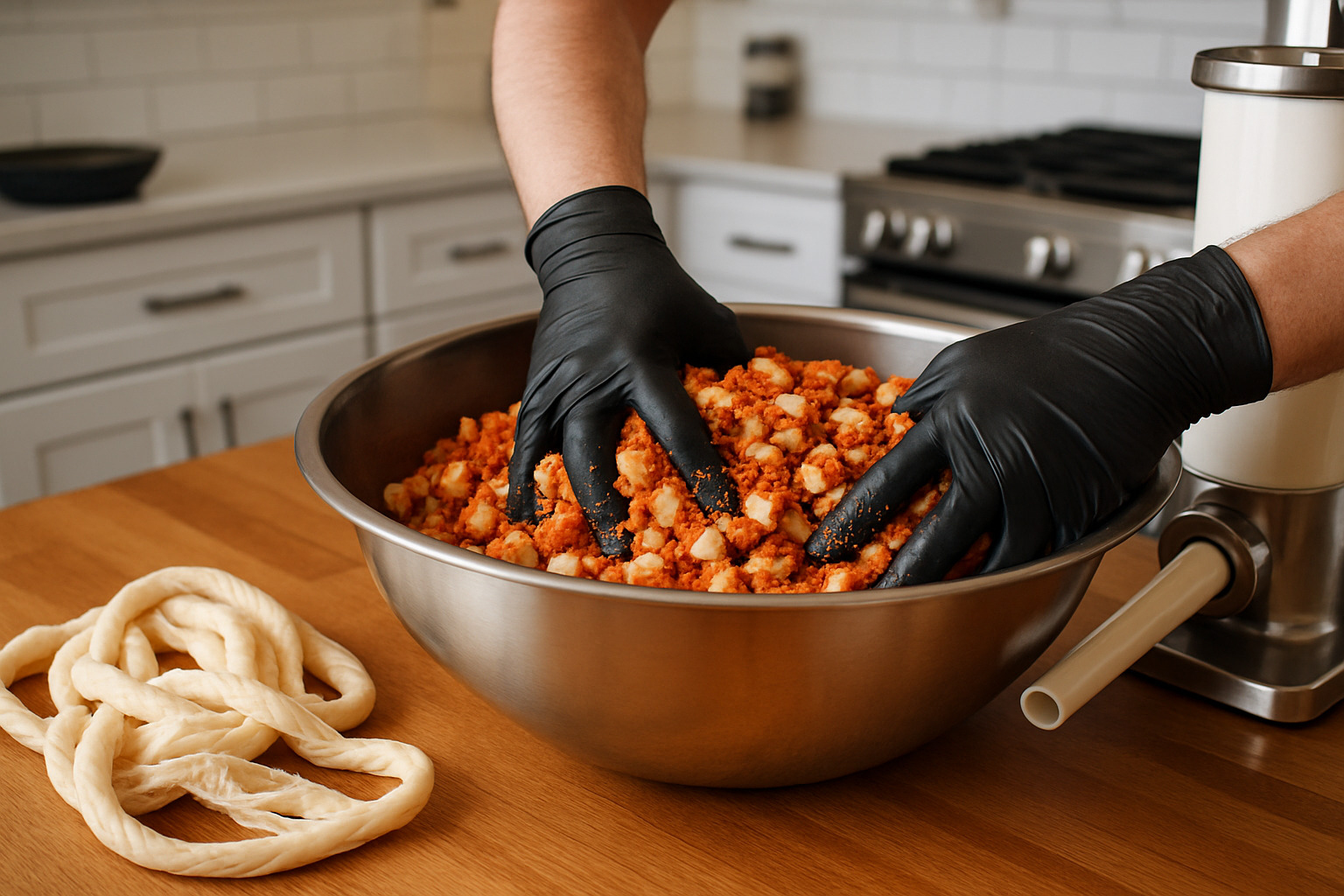
The seasoning blend is where regional differences really shine. Spanish chorizo keeps things simple with garlic, salt, and oregano forming the backbone alongside that precious pimentón. Mexican versions add ground chiles like ancho, guajillo, or chipotle, plus cumin and vinegar for tang. Portuguese varieties might surprise you with cinnamon, bay leaves, and wine.
The traditional preparation follows time-honored steps. First, the pork shoulder and fatback get cubed and tossed with spice blends, then the seasoned meat rests refrigerated for 24 hours. Next comes the grinding – cold meat passes through a grinder’s small die over ice to prevent fat smearing. The mixing stage is crucial but brief, followed by stuffing into natural hog casings. Finally, Spanish chorizo hangs in controlled environments for 50+ days during curing and smoking.
This traditional process, known as La Matanza, still happens in Spanish villages during winter months. The Cookbook:Chorizo Media resource offers detailed traditional techniques for those interested in authentic methods.
Homemade Chorizo Basics
Making chorizo at home requires a meat grinder, natural casings, and patience. The golden rule is keeping everything cold throughout the process, because warm fat creates a greasy, unpleasant texture.
For a basic Mexican chorizo (serving 12, about 3 pounds), you’ll need 2.5 pounds of pork shoulder and half a pound of pork fatback, both cubed. Season with 3 tablespoons of ancho chile powder, 2 tablespoons of salt, 4 minced garlic cloves, and a teaspoon of oregano. Add half a teaspoon each of cinnamon and cumin, plus a quarter teaspoon each of black pepper and ground cloves. Finish with 2 tablespoons of cold cider vinegar.
This yields approximately 335 calories, 28g fat, 2g carbs, and 18g protein per serving.
Vegetarian & Vegan Alternatives
The popularity of chorizo has inspired creative plant-based alternatives. Soyrizo leads the commercial market, using soy protein, paprika, and chile peppers to mimic traditional chorizo’s taste and texture.
Homemade vegan chorizo typically combines mushrooms or lentils for umami and texture, smoked paprika for color and flavor, and nutritional yeast for richness. Traditional seasonings like garlic, cumin, and oregano stay the same, while tomato paste helps with color and binding.
These alternatives work particularly well in dishes where chorizo is crumbled and mixed with other ingredients, like breakfast scrambles or pasta sauces.
Cooking with Chorizo: Dishes & Techniques
Chorizo’s incredible versatility makes it a kitchen superstar, whether you’re serving neat Spanish tapas or whipping up hearty Mexican breakfast tacos. The beauty of this sausage lies in how it adapts to any meal – from simple weeknight dinners to impressive dinner party spreads.
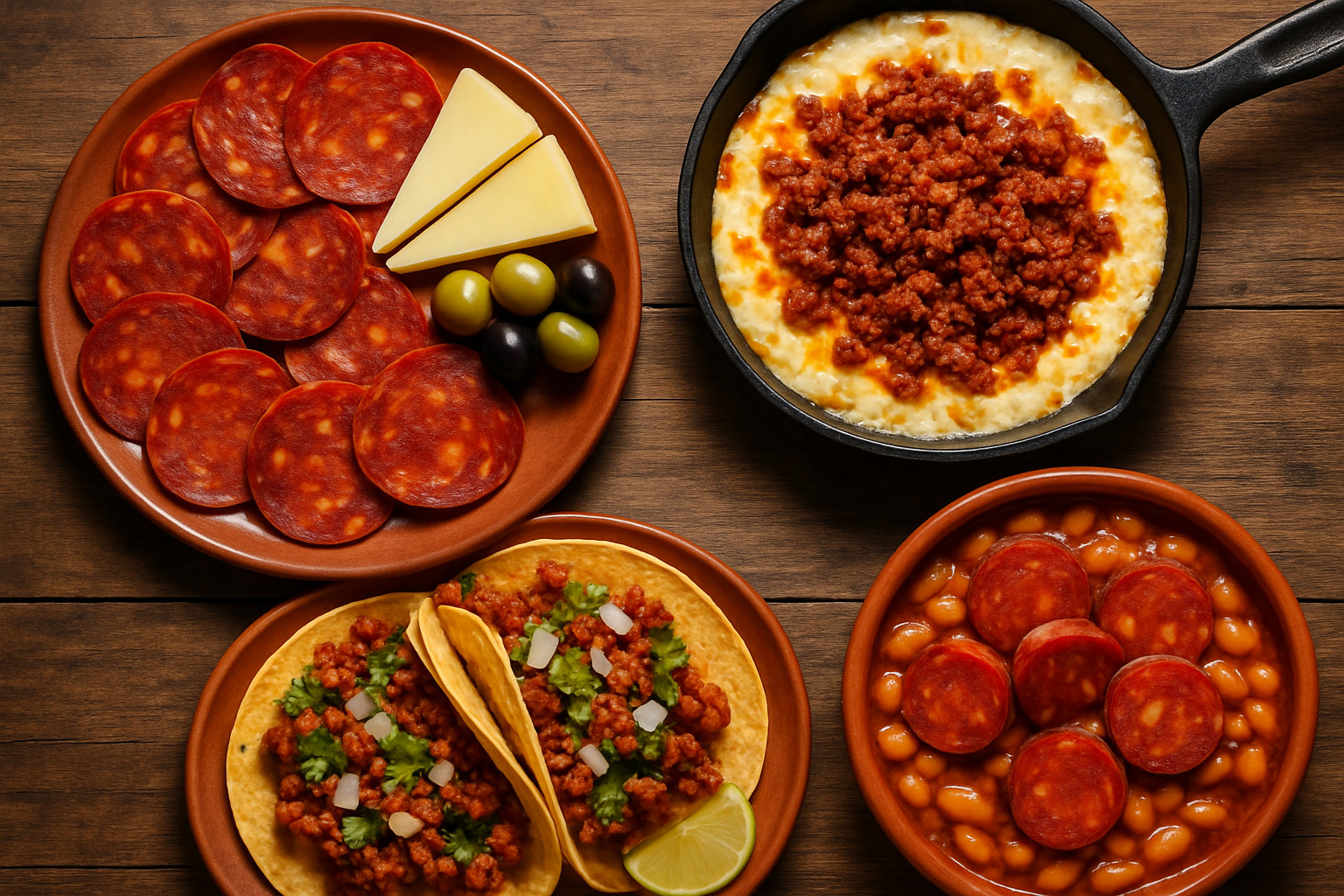
Spanish cured chorizo couldn’t be easier to enjoy – simply slice it thin and arrange with Manchego cheese, olives, and crusty bread for instant tapas. No cooking required! The smoky paprika and rich pork fat create the perfect balance of salt and spice that pairs beautifully with a glass of Spanish wine.
When you want something more substantial, chorizo transforms classic dishes into flavor powerhouses. In traditional paella, chorizo adds smoky depth that infuses the entire rice dish. Portuguese feijoada showcases chouriço alongside beans and other meats for a soul-warming stew that’s perfect for cold evenings.
Mexican fresh chorizo brings completely different possibilities to your kitchen. Huevos con chorizo turns ordinary scrambled eggs into a spicy, satisfying breakfast that’ll wake up your taste buds. The rendered fat from cooking chorizo becomes liquid gold – use it to sauté vegetables or create the most flavorful migas you’ve ever tasted.
For modern fusion trips, try adding chorizo to quesabirria for extra richness, or explore how it lifts simple queso fundido into an irresistible appetizer. The sausage’s bold flavors play well with melted cheese and warm tortillas.
Street food traditions offer endless inspiration for home cooks. South American choripán proves that sometimes the simplest combinations work best – grilled chorizo nestled in crusty bread with chimichurri sauce creates perfect handheld satisfaction.
Cooking Fresh Chorizo Safely
Fresh chorizo requires a bit more attention than its cured cousins, but the results are worth the extra effort. Since Mexican-style chorizo is raw pork, proper cooking isn’t just about flavor – it’s about safety too.
Start by removing the casing completely. Cut one end of the sausage and squeeze out the filling like toothpaste – the plastic or natural casing isn’t meant to be eaten. Heat a nonstick pan over medium-high heat with just a touch of oil.
Crumble the chorizo into the pan, breaking it apart like ground beef. Cook for 5-7 minutes, stirring frequently, until it’s beautifully browned and crumbly. The internal temperature should reach 160°F for food safety, but you’ll know it’s ready when it looks golden and smells incredible.
Here’s a pro tip: don’t drain all that rendered fat! It’s packed with smoky, spicy flavor that can transform roasted potatoes, sautéed greens, or braised beans into something special.
Pairing Ideas & Street Food Inspiration
Chorizo’s bold personality loves cooling companions that balance its heat and richness. Fresh avocado in breakfast tacos provides creamy relief from spicy chorizo, while mild cheeses like queso fresco or mozzarella let the sausage’s flavors shine without competing.
Sweet elements work surprisingly well too – caramelized onions or roasted red peppers add natural sweetness that complements chorizo’s smoky heat. For lunch bowls, try pairing spicy chorizo with creamy yogurt and crispy chickpeas for a satisfying mix of textures and temperatures.
Street food traditions from around the world show how versatile chorizo can be. Mexican tortas often feature chorizo with beans, avocado, and pickled jalapeños for a perfect balance of rich, creamy, and tangy flavors. Spanish bocadillos keep things simple with chorizo, fresh tomato, and good olive oil on crusty bread.
When it comes to drinks, chorizo’s richness calls for bright acidity to cut through the fat. Spanish Albariño or Portuguese Vinho Verde provide crisp contrast, while Mexican beer with lime offers refreshing relief from the heat. Bold red wines like Tempranillo or Garnacha can stand up to chorizo’s smoky intensity without being overwhelmed.
Nutrition, Health & Storage
Chorizo isn’t exactly a health food. This delicious sausage packs a serious caloric punch, with a typical serving of chorizo and eggs clocking in at 232 calories, 16g fat, and 20g protein. That high-fat, high-protein profile makes it a surprising fit for ketogenic diets, but it definitely calls for moderation.

The sodium content deserves attention – chorizo can deliver 14% of your daily sodium needs in a single serving. If you’re watching your salt intake, balance chorizo-heavy meals with plenty of fresh vegetables.
But it’s not all bad news! Chorizo provides complete protein and valuable B vitamins, especially B12 and niacin. Spanish chorizo brings bonus antioxidants from that gorgeous smoked paprika. The traditional fermentation process in cured chorizo may even offer some probiotic benefits.
The key is treating chorizo like a flavorful accent rather than the main event. A little goes a long way in adding smoky richness to eggs, beans, or rice dishes.
Buying Quality Chorizo
Finding great chorizo means knowing what to look for, and the signs vary dramatically between Spanish and Mexican varieties.
When shopping for Spanish chorizo, look for those prestigious PGI (Protected Geographical Indication) labels. Don’t be alarmed by white, powdery mold on cured varieties; that’s actually a sign of proper aging. The ultimate prize is anything labeled Ibérico or Ibérico Bellota, which means premium pork from acorn-fed pigs.
Mexican chorizo shopping requires a different approach since you’re dealing with a fresh product. Your best bet is reputable butchers or specialty stores that move inventory quickly. Check expiration dates religiously and look for natural casings rather than plastic.
Proper Storage Tips
Chorizo storage is all about understanding what type you’re dealing with. Whole chorizo typically lasts 1-2 weeks in the refrigerator, though cured Spanish varieties outlast fresh Mexican ones by several days.
Once you slice into your chorizo, use it within a week. Fresh chorizo becomes even more perishable once you break the casing – plan to use it within 2-3 days.
Freezing works beautifully for most chorizo varieties, extending their life up to 3 months. Just wrap everything tightly to prevent freezer burn. Cooked chorizo keeps 3-4 days in the refrigerator.
The golden rule: keep it wrapped in plastic or sealed in airtight containers. This prevents the sausage from drying out and stops it from absorbing other flavors from your refrigerator.
Frequently Asked Questions about Chorizo
What gives chorizo its red color?
That beautiful deep red color that makes chorizo instantly recognizable comes from different sources depending on where your sausage originated. Spanish chorizo gets its gorgeous crimson hue from pimentón – those wonderful smoked, dried red peppers that are ground into paprika. This isn’t just about making the sausage look pretty; the pimentón is doing double duty by providing that signature smoky flavor while acting as a natural preservative.
Mexican chorizo takes a different approach, relying on ground chile peppers like ancho, guajillo, or chipotle for both its fiery color and heat. Some commercial producers use annatto seed (achiote) as a more budget-friendly coloring agent, which gives you that vibrant red without the complex flavors of traditional chiles.
Here’s a helpful tip: the intensity of that red color often tells you what you’re in for flavor-wise. Deeper red usually means more paprika or chiles, which translates to bolder, more intense taste.
How is Spanish chorizo different from Mexican chorizo?
The differences between Spanish and Mexican chorizo are like night and day – they’re completely different approaches to the same basic idea of spiced pork sausage.
Spanish chorizo is the patient, refined cousin. It’s cured and fermented, similar to salami, which means it’s firm enough to slice thin and eat straight from the package. The primary seasoning is that wonderful smoked paprika (pimentón), giving it a deep, smoky flavor that’s more sophisticated than spicy. Spanish chorizo has staying power too – it lasts longer in your fridge and holds its shape beautifully when cooked.
Mexican chorizo is the wild, immediate relative. It’s fresh and raw, which means you absolutely must cook it before eating. It’s seasoned with ground chiles, vinegar, and spices like cumin and oregano, creating a flavor profile that’s spicier and more acidic than its Spanish cousin. The texture is deliberately loose and crumbly, designed to break apart during cooking and meld with other ingredients.
These fundamental differences mean you can’t just swap one for the other in recipes, though Spanish chorizo can sometimes substitute for Mexican in cooked dishes if you’re in a pinch.
Are there vegan or vegetarian chorizo options?
Absolutely! The incredible popularity of chorizo has inspired food makers to create plant-based alternatives that capture those beloved flavors without the meat. Soyrizo leads the pack as the most widely available commercial option, using soy protein to replicate chorizo’s texture while keeping all those traditional spices we love.
If you’re feeling adventurous, homemade vegan chorizo often uses mushrooms or lentils for that meaty umami and texture, smoked paprika for authentic flavor and color, and nutritional yeast for richness. Traditional spices like garlic, cumin, and oregano round out the flavor profile.
These plant-based alternatives work beautifully in dishes where chorizo is crumbled and cooked with other ingredients – think pasta sauces, breakfast scrambles, or tacos. While they might not perfectly replicate the fat content and mouthfeel of pork chorizo, they capture much of that distinctive flavor profile that makes chorizo so irresistible.
Conclusion
Our journey through chorizo reveals a sausage that’s far more than just seasoned pork – it’s a delicious thread connecting cultures across continents. From its humble beginnings in medieval Spanish villages to its starring role in modern fusion kitchens, chorizo tells the story of how food traditions travel, adapt, and thrive.
Think about it: when you bite into crispy chorizo crumbles in your morning breakfast tacos, you’re tasting the same basic recipe that Spanish shepherds perfected centuries ago. Yet that Mexican chorizo, with its bright chile heat and tangy vinegar, represents something entirely new – a beautiful example of culinary evolution in action.
The incredible diversity we’ve explored – from wine-infused Portuguese chouriço to sweet Filipino longganisa – shows how one simple concept can flourish when it meets local ingredients and passionate cooks. Even today’s plant-based alternatives prove that chorizo’s appeal transcends dietary boundaries. The flavors are just too good to give up.
For food lovers planning their next culinary trip, chorizo offers a perfect starting point. Visit a busy Mexican market and watch vendors grill fresh chorizo for tortas. Stop by a Spanish tapas bar and savor paper-thin slices of aged chorizo seco with local wine. Each experience connects you to generations of tradition and the passionate people who keep these flavors alive.
At The Dining Destination, we know that understanding ingredients like chorizo makes every meal more meaningful. Whether you’re exploring our global culinary tours or simply experimenting in your own kitchen, chorizo opens doors to authentic flavors and memorable experiences.
The next time you encounter chorizo – whether you’re making it from scratch or finding a new regional variety – remember that you’re participating in one of food’s greatest success stories. This humble sausage has traveled the world, adapted to countless local tastes, and continues to bring joy to tables everywhere.
That’s the real magic of chorizo: it connects us to both our culinary heritage and our delicious future, one perfectly spiced bite at a time.

